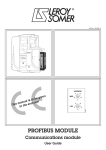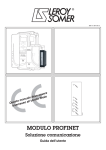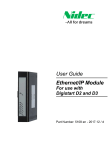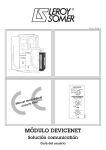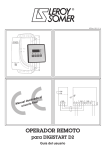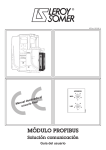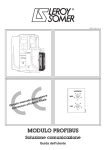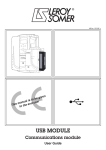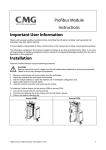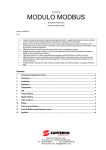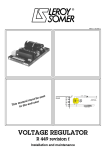Download Profinet Module User Guide
Transcript
5201 en - 2014.09 / a Ready Stop Run Start Trip Local Reset LCL RMT er w Po en ro Er giv e b is to er l a u an d us m n s e i e Th to th 1 2 us k 1 /RX k 2 /RX at Lin TX Lin TX St 2 Communications module User Guide 14702.A r 1 PROFINET MODULE General Information The manufacturer accepts no liability for any consequences resulting from inappropriate, negligent or incorrect installation or adjustment of the optional parameters of the equipment or from mismatching the starter with the motor. The contents of this guide are believed to be correct at the time of printing. In the interests of commitment to a policy of continuous development and improvement, the manufacturer reserves the right to change the specification of the product or its performance, or the content of the guide without notice. All rights reserved. No parts of this guide may be reproduced or transmitted in any form or by any means, electrical or mechanical including, photocopying, recording or by an information storage or retrieval system, without permission in writing from the publisher. Copyright: © September 2014 LEROY SOMER Issue A Contents 1. Important User Information ...................................................................................... 4 2. Installation ................................................................................................................. 5 3. Connection................................................................................................................. 6 4. Device Configuration ................................................................................................ 8 5. Operation ................................................................................................................. 10 1.1 1.2 1.3 1.4 2.1 3.1 3.2 3.3 3.4 3.5 4.1 Safety........................................................................................................................................4 Product Design .........................................................................................................................4 Compatibility .............................................................................................................................4 Disclaimer .................................................................................................................................4 Installation Procedure ...............................................................................................................5 Soft Starter Connection ............................................................................................................6 Network Connection .................................................................................................................6 Network Establishment .............................................................................................................7 Communication Protocols .........................................................................................................7 Addressing ................................................................................................................................7 Ethernet Device Configuration Tool ..........................................................................................8 5.1 5.2 5.3 Device Classification...............................................................................................................10 Master Configuration ..............................................................................................................10 LEDs .......................................................................................................................................10 6. Packet Structures .................................................................................................... 11 6.1 6.2 6.3 6.4 6.5 Ensuring Safe and Successful Control ...................................................................................11 Control Commands (Write Only).............................................................................................11 Status Commands (Read Only) ..............................................................................................12 Parameter Management (Read/write) ....................................................................................17 Examples ................................................................................................................................18 7. Network Design ....................................................................................................... 19 8. Specifications .......................................................................................................... 21 7.1 7.2 7.3 7.4 Star Topology .........................................................................................................................19 Line Topology .........................................................................................................................19 Ring Topology.........................................................................................................................20 Combined Topologies .............................................................................................................20 Profinet Module User Guide Issue A www.leroy-somer.com 3 1. Important User Information 1.1 Safety Observe all necessary safety precautions when controlling the soft starter remotely. Alert personnel that machinery may start without warning. It is the installer's responsibility to follow all instructions in this manual and to follow correct electrical practice. Close attention is required to the electrical installation and the system design to avoid hazards either in normal operation or in the event of equipment malfunction. System design, installation, commissioning and maintenance must be carried out by personnel who have the necessary training and experience. They must read this safety information and this guide carefully. 1.2 Product Design The Profinet Module allows a LEROY-SOMER soft starter to connect to an Ethernet network and be controlled or monitored using an Ethernet communication model. Separate modules are available for Profinet, Modbus TCP and Ethernet/IP networks. The Profinet Module operates at the application layer. Lower levels are transparent to the user. Familiarity with Ethernet protocols and networks is required to operate the Profinet Module successfully. For difficulties using this device with third party products, including PLCs, scanners and commissioning tools, contact the relevant supplier. 1.3 Compatibility The Profinet Module is compatible with the following LEROY-SOMER soft starters: • • 1.4 Digistart D2 – 110/240 Vac control voltage. The Profinet Module is not suitable for use with Digistart D2 starters using 380/440 Vac control voltage. Digistart D3 – all models. Disclaimer The examples and diagrams in this manual are included solely for illustrative purposes. The information contained in this manual is subject to change at any time and without prior notice. In no event will responsibility or liability be accepted for direct, indirect or consequential damages resulting from the use or application of this equipment. 4 www.leroy-somer.com Profinet Module User Guide Issue A 2. CAUTION 2.1 1. 2. 3. 4. 5. 6. Installation Remove mains and control voltage from the soft starter before attaching or removing accessories. Failure to do so may damage the equipment. Installation Procedure Remove control power and mains supply from the soft starter. Fully pull out the top and bottom retaining clips on the module. Line up the module with the comms port slot. Push in the top and bottom retaining clips to secure the module to the starter. Insert the network connector. Apply control power to the soft starter. Figure 2-1 Attach the module to the starter 2 3 10178.B 1 Remove the module using the following procedure: 1. Remove control power and mains supply from the soft starter. 2. Disconnect all external wiring from the module. 3. Fully pull out the top and bottom retaining clips on the module. 4. Pull the module away from the soft starter. Profinet Module User Guide Issue A www.leroy-somer.com 03550.B Figure 2-2 Remove the module from the starter 5 3. Connection 3.1 Soft Starter Connection The Profinet Module is powered from the soft starter. Digistart D2: For the Profinet Module to accept fieldbus commands, a link must be fitted across terminals CSL-DI2 on the soft starter. The Profinet Module is not suitable for use with Digistart D2 starters using 380/440 Vac control voltage. Digistart D3: Input links are required across the stop and reset inputs if the soft starter is being operated in Remote mode. In Local mode, links are not required. NOTE Digistart D3: Control via the fieldbus communication network is always enabled in local control mode, and can be enabled or disabled in remote control mode (Pr 3O Comms in Remote). See the soft starter user manual for parameter details. Figure 3-1 Profinet Module connections Digistart D2 Digistart D3 1 1 2 2 3 15634.A 15633.A 3 Digistart D2 Digistart D3 (Remote mode) CSL, DI2: Stop input DI2, +24V: Stop input DI3, +24V: Reset input Profinet Module Profinet Module RJ45 Ethernet ports RJ45 Ethernet ports 3.2 Network Connection 3.2.1 Ethernet Ports The Profinet Module has two Ethernet ports. The ports are equal and interchangeable - if only one connection is required, either port can be used. 3.2.2 Cables Use Category 5, 5e, 6 or 6e cable to connect to the Profinet Module. 3.2.3 EMC Precautions To minimise electromagnetic interference, Ethernet cables should be separated from motor and mains cables by 200 mm. If the Ethernet cable must cross motor or mains cables, the crossing should be at an angle of 90°. 6 www.leroy-somer.com Profinet Module User Guide Issue A 3.3 Network Establishment The controller must establish communications directly with each module before the module can participate in the network. Once communications are established, the module can participate in an existing network. 3.4 Communication Protocols The Profinet Module supports the following protocols: Table 3-1 Supported communication protocols CL-RPC Connectionless remote procedure call DCP Discovery and configuration protocol LLDP Link layer discovery protocol MRP Media redundancy protocol RTC Real-time cyclic protocol; Class 1 and 2 (unsynchronised), Class3 (synchronised) SNMP Simple network management protocol The Profinet Module does not support the following protocols: Table 3-2 Unsupported communication protocols DHCP Dynamic host configuration protocol MCR Multicast communication relation RTA Real-time acyclic protocol Flexible RT_CLASS_2 Real-time cyclic protocol; Class 2 synchronised RT_CLASS_UDP Unsynchronised cross-subnet communication between different subnets The maximum data length for input and output data is 256 bytes each. 3.5 Addressing Each device in a network is addressed using a MAC address and an IP address, and can be assigned a symbolic name associated with the MAC address. • • • The module must be assigned a static IP address (see Ethernet Device Configuration Tool on page 8), or can be assigned an IP address by the master via DCP. The Profinet Module does not support DHCP addressing. The symbolic name is optional and must be configured within the device. The MAC address is fixed within the device and is printed on a label on the front of the module. Figure 3-2 MAC ID location 1 Profinet Module User Guide Issue A 2 www.leroy-somer.com 14701.B Er ro r Sta tu s Li nk 1 TX /R X Li 1 nk 2 TX /R X 2 Po we r MAC: 00-02-A2-25-DC-B3 7 4. Device Configuration To permanently configure attributes in the Profinet Module, use the Ethernet Device Configuration Tool and untick "Store settings temporary". NOTE 4.1 The Error LED flashes whenever the module is receiving power but is not connected to a network. The Error LED will flash throughout the configuration process. Ethernet Device Configuration Tool The Ethernet Device Configuration Tool can be downloaded from www.leroy-somer.com. To configure the device using the Ethernet Device Configuration Tool: 1. Attach the module to a soft starter. 2. Connect one Ethernet port on the module to the Ethernet port of the PC. 3. Apply control power to the soft starter. 4. Start the Ethernet Device Configuration Tool. 5. Click on Search Devices. The software will search for connected devices. 6. The search results will contain two entries for each connected device. Select the DCP Protocol entry for the required device. 8 www.leroy-somer.com Profinet Module User Guide Issue A 7. To set a static IP address, click Configure then select Set IP address. 8. To configure a device name, click Configure then select Device Name. Profinet Module User Guide Issue A www.leroy-somer.com 9 5. Operation The Profinet Module has been designed for use in a system complying with the Profinet standard. For successful operation, the controller must also support all functions and interfaces described in this document. 5.1 Device Classification The Profinet Module is a Profinet IO-Device and must be managed by an IO-Controller over Ethernet. 5.2 Master Configuration Import the latest GSDML file into your Master configuration tool. This file is available from www.leroy-somer.com. If your Master uses on-screen icons, two graphic bitmap files are available from the website. SSPM_N.bmp indicates normal mode. SSPM_D.bmp indicates diagnostic mode. 5.3 LEDs Figure 5-1 Feedback LEDs w Po LED name Power er Error Link x TX/RX x Off On Off Flashing On Off Flashing Off On Flashing On Description Module is not powered up. Module is receiving power. No error. No data exchange. No physical link or slow physical link. No configuration. No error. DCP signal service initiated via the bus. No network connection. Connected to a network. Invalid controller. Transmitting data. 14702.A 2 1 2 X X 1 2 r us ro tat ink X/R ink X/R Er T T L L S 1 10 Status LED Status www.leroy-somer.com Profinet Module User Guide Issue A 6. NOTE Packet Structures Some soft starters do not support some functions. The following functions are only available with Digistart D3 soft starters: parameter management, dual motor control, digital inputs, jog, current measurement in amperes, power information, warnings. 6.1 Ensuring Safe and Successful Control Data written to the Profinet Module will remain in its registers until the data is overwritten or the module is reinitialised. The Profinet Module will not transfer successive duplicate commands to the soft starter. NOTE If the soft starter is started via fieldbus communications but stopped via the keypad or a remote input, an identical start command cannot be used to restart the starter. In order to operate safely and successfully in an environment where the soft starter may also be controlled via the keypad or the remote inputs (as well as via fieldbus communications), a control command should be immediately followed by a status query to confirm the command has been actioned. 6.2 Control Commands (Write Only) Use the following structures to send a control command to the soft starter: Table 6-1 Control I/O data structure Bit 7 Reserved Bit 6 Reserved Bit 5 Reserved Bit 7 Reserved Bit 6 Reserved Bit 5 Reserved 6.2.1 Byte 0 Bit 4 Bit 3 Bit 2 Quick stop Motor set (coast to stop) Byte 1 Bit 4 Bit 3 Bit 2 Reset Reserved Reserved Bit 1 Reserved Bit 0 Reserved Bit 1 Reserved Bit 0 Fwd run Motor Set Bits Selects which parameter set to use when starting: 0 = selected from soft starter remote input (programmable input must be set to 'Motor Set Select') 1 = soft starter primary motor set (ensure soft starter programmable input is not set to 'Motor Set Select') 2 = soft starter secondary motor set (ensure soft starter programmable input is not set to 'Motor Set Select') 3 = Reserved 6.2.2 Quick Stop Bit When Fwd run bit changes from 1 to 0: 0 = stop action will be a soft stop (as selected on the soft starter). 1 = stop action will be a quick stop (ie coast to stop). NOTE 6.2.3 The Quick stop bit must be set to 0 before the soft starter can perform a start. Forward Run When Forward run changes from 0 to 1, the soft starter will start according to the Motor set setting. When Forward run changes from 1 to 0, the soft starter will stop according to the Quick stop setting. Profinet Module User Guide Issue A www.leroy-somer.com 11 6.3 Status Commands (Read Only) Starter status information is always available when the module is connected to a soft starter, in the following format: Table 6-2 Status word structure Byte 0 Byte 1 Byte 2 Byte 3 Byte 4 Byte 5 Byte 6 Byte 7 Byte 8 Byte 9 Control status Starter state Trip code Motor current Motor temperature (low byte)/(high byte) (low byte)/(high byte) (low byte)/(high byte) (low byte)/(high byte) (low byte)/(high byte) 6.3.1 Control status Table 6-3 Status word structure Bit 7 Ramping Bit 6 Local mode Bit 5 Bit 7 Reserved Bit 6 Reserved Bit 5 Reserved Byte 0 Bit 4 Bit 3 Bit 2 Motor current (% FLC) 1 Byte 1 Bit 4 Bit 3 Bit 2 Warning Fault Reserved Bit 1 Bit 0 Bit 1 On Bit 0 Ready 1 Motor current (% FLC) represents current as a percentage of the set motor full load current. A maximum value of 63 represents 200% full load current. To convert this value to a readable percentage, divide by 0.315. For models D3-1x-0053-B and smaller this value will be 10 times greater than the value displayed on the keypad. Ready is set when the soft starter is ready to start the motor. On is set when the soft starter is starting, running or soft stopping the motor. Warning is set when the soft starter detects a warning condition. Fault is set when the soft starter has tripped. Ramping is set when the soft starter is starting or soft stopping the motor. Local is set when the soft starter is set to Local mode. 6.3.2 Starter state Table 6-4 Status word structure Byte 2 Bit 7 Bit 6 Bit 5 CommuniInitialised Current cation failure (set after first exceeds FLC between start once module and phase starter sequence has been confirmed) Bit 4 Positive phase sequence Bit 3 Bit 2 Bit 1 Bit 0 The decimal value of bits 0 to 3 indicates the starter's state: 0 = Unknown (communication error between module and soft starter) 1 = Ready 2 = Starting 3 = Running 4 = Stopping 5 = Not ready (restart delay, restart temperature check, run simulation, input A (DI4, +24V) not shorted) 6 = Tripped 7= Menu open (cannot start) 8 = Jog forward 9 = Jog reverse Byte 3 Reserved 12 www.leroy-somer.com Profinet Module User Guide Issue A 6.3.3 Trip Codes Table 6-5 Trip messages Trip Code 1 2 3 4 5 6 7 8 10 11 12 13 14 15 16 17 201 23 24 26 27 28 29 30 31 32 332 35 36 37 381 391 401 411 421 431 45 46 47 48 255 1 2 Description Digistart D2 Digistart D3 Excess start time Motor overload Motor thermistor Current imbalance Frequency Phase sequence Instantaneous overcurrent Power loss Heatsink overtemperature Motor Connection Tx Input A trip FLC too high Unsupported option (function not available in inside delta) Starter communication (between module and soft starter) Network communication (between module and network) Internal fault x (where x is the fault code detailed in the table below) Ground fault Parameter out of range Input B trip L1 phase loss L2 phase loss L3 phase loss L1-T1 shorted L2-T2 shorted L3-T3 shorted Motor 2 overload Time-overcurrent (Bypass overload) Battery/clock Thermistor circuit RTD/PT100 A RTD/PT100 B RTD/PT100 C RTD/PT100 D RTD/PT100 E RTD/PT100 F RTD/PT100 G RTD/PT100 X Circt Analog input trip Overpower Underpower No trip Available with Digistart D3 only if the appropriate option card is fitted. For Digistart D3, time-overcurrent protection is only available on internally bypassed models. Profinet Module User Guide Issue A www.leroy-somer.com 13 Internal Fault x The table below details the internal fault code associated with trip code 17. Table 6-6 Internal fault X Internal fault 70 to 72 73 74 to 76 77 to 79 80 to 82 83 84 to 98 6.3.4 Message displayed on the keypad Current Read Err Lx ATTENTION! Remove Mains Volts Motor Connection Tx Firing Fail Px VZC Fail Px Low Control Volts Internal fault X Contact your local supplier with the fault code (X). Motor current Bytes 6 and 7 report motor current in amperes. For models D3-1x-0053-B and smaller this value will be 10 times greater than the value displayed on the keypad. 6.3.5 Motor temperature Bytes 8 and 9 report motor temperature as a percentage of the motor service factor (calculated by the soft starter's thermal model). 14 www.leroy-somer.com Profinet Module User Guide Issue A 6.3.6 Extended information Bytes 10~73 report information from the soft starter’s internal registers. Table 6-7 Internal register data Byte 10-11 Description Version 12-13 14-15 Device details Changed parameter 2 number 16-17 Changed parameter 2 value 18-19 Starter state Bits 0 to 5 6 to 8 9 to 15 0 to 7 8 to 15 0 to 13 14 to 15 0 to 4 5 6 7 8 9 20-21 Current 22-23 Current 24-25 Motor temperature 26-27 Power 28-29 % Power factor 30-31 32-33 Reserved 4 Current 34-35 Current 5 4 Profinet Module User Guide Issue A 10 to 15 0 to 13 14 to 15 0 to 9 10 to 15 0 to 7 8 to 15 0 to 11 12 to 13 14 to 15 0 to 7 8 to 15 0 to 15 0 to 13 14 to 15 0 to 13 14 to 15 Details Reserved Product parameter list version Product type code 1 0 = no parameters have changed 1 to 255 = index number of the last parameter changed Total number of parameters available in the starter Value of the last parameter that was changed, as indicated in register 2 Reserved 0 = Reserved 1 = Ready 2 = Starting 3 = Running 4 = Stopping 5 = Not ready (restart delay, restart temperature check, run simulation, input A (DI4, +24V) not shorted) 6 = Tripped 7 = Programming mode 8 = Jog forward 9 = Jog reverse 1 = Warning 0 = Unintialised 1 = Initialised 0 = Local control 1 = Remote control 0 = Parameter(s) have changed since last parameter read 1 = no parameters have changed 2 0 = Negative phase sequence 1 = Positive phase sequence See Trip Codes on page 13 3 Average rms current across all three phases 4 Reserved Current (% motor FLC) Reserved Motor 1 thermal model (%) Motor 2 thermal model (%) Power Power scale Reserved 100% = power factor of 1 Reserved Phase 1 current (rms) Reserved Phase 2 current (rms) Reserved www.leroy-somer.com 15 Byte 36-37 Description 4 Current 38-39 40-41 42-41 44-45 Reserved Reserved Reserved Parameter list version number 46-47 Digital Input state Bits 0 to 13 Phase 3 current (rms) 14 to 15 Reserved Details 0 to 7 Parameter list minor revision 8 to 15 0 to 15 Parameter list major version For all inputs, 0 = open, 1 = closed (shorted) 0 = Start 1 = Stop 2 = Reset 3 = Input A 4 = Input B 5 = Input C, if fitted 6 = Input D, if fitted 7 to 15 = Reserved 48-73 Reserved 1 Product type code: 4 = Digistart D2 8 = Digistart D3 2 Reading register 3 (Changed parameter value) will reset registers 2 (Changed parameter number) and 4 (Parameters have changed). Always read registers 2 and 4 before reading register 3. 3 Bits 10 to 15 of register 4 report the soft starter's trip or warning code. If the value of bits 0 to 4 is 6, the soft starter has tripped. If bit 5 = 1, a warning has activated and the starter is continuing to operate. 4 For models D3-1x-0053-B and smaller this value will be 10 times greater than the value displayed on the keypad. 5 Powerscale functions as follows: 0 = multiply Power by 10 to get W 1 = multiply Power by 100 to get W 2 = Power is represented in kW 3 = multiply Power by 10 to get kW 16 www.leroy-somer.com Profinet Module User Guide Issue A 6.4 Parameter Management (Read/write) The Profinet Module can read parameter values from and write parameter values to the soft starter. The module handles one parameter at a time. The module references parameters according to their position in the starter's parameter list. Parameter number 1 corresponds to Pr 1A Motor Full Load Current The Digistart D3 has 160 parameters. Parameter number 160 corresponds to Pr 16X Low Control Volts. Use the following structures to read parameter values from or write parameter values to the soft starter. Master > Slave output bytes are structured as follows. Table 6-8 Programming output byte structure • • Bit 7 Byte 2 Byte 3 Byte 4 Byte 5 Bit 6 Bit 5 Bit 4 Bit 3 Bit 2 Bit 1 Bit 0 Parameter number to read/write Write Read Reserved Reserved Reserved Reserved Reserved Reserved parameter parameter Low byte parameter value to write to soft starter/ zero data values for read High byte parameter value to write to soft starter/ zero data values for read Slave > Master input bytes are structured as follows. Table 6-9 Programming input byte structure Byte 114 Byte 115 Bit 7 Bit 6 Reserved Reserved Byte 116 Byte 117 Profinet Module User Guide Issue A Bit 5 Bit 4 Bit 3 Echo parameter number Bit 2 Bit 1 Bit 0 Invalid Invalid Reserved parameter parameter value number Low byte parameter value read from soft starter High byte parameter value read from soft starter Reserved Reserved Reserved www.leroy-somer.com 17 6.5 Examples 6.5.1 Control Commands Start the motor using parameter set 1 Byte 2 Byte 3 Byte 4 Byte 5 Byte 6 Byte 7 Start the motor, select via remote input Byte 2 Byte 3 Byte 4 Byte 5 Byte 6 Byte 7 Stop the motor using the programmed soft stop for motor set 2 Byte 1 Byte 2 Byte 3 Byte 4 Byte 5 Byte 6 0 Byte 7 Byte 0 4 Byte 1 1 Byte 0 0 Byte 1 1 Byte 0 8 Byte 0 16 Byte 1 0 Byte 2 Quick stop the motor Byte 3 Byte 4 Byte 0 ≤ 28 Byte 1 8 Byte 2 Reset a trip Byte 3 Byte 4 6.5.2 Byte 5 Byte 6 Byte 7 Byte 5 Byte 6 Byte 7 Read control status - Ready Byte 2 Byte 3 Byte 4 Byte 5 Byte 6 Byte 7 Status Commands Byte 0 0 Byte 1 1 Byte 0 Byte 1 Byte 6 Byte 7 Byte 0 Read starter status - Tripped, trip code 4 (Current imbalance) Byte 1 Byte 2 Byte 3 Byte 4 Byte 5 Byte 6 6 0 4 0 Byte 7 6.5.3 Byte 2 3 Read starter status - Running Byte 3 Byte 4 Byte 5 0 Parameter Read/Write Byte 0 Write parameter to starter: parameter number 1, 1A Motor Full Load Current = 55 Byte 1 Byte 2 Byte 3 Byte 4 Byte 5 Byte 6 Byte 7 1 4 55 0 Byte 112 Byte 113 Acknowledge parameter write Byte 114 Byte 115 Byte 116 Byte 117 1 0 55 0 Byte 118 Byte 119 Byte 0 Read parameter from Digistart D3: parameter number 12, 2H Stop Mode Byte 1 Byte 2 Byte 3 Byte 4 Byte 5 Byte 6 12 2 0 0 Byte 7 Byte 112 Parameter read response: Pr 2H Stop Mode = 1 (TVR Soft Stop) Byte 113 Byte 114 Byte 115 Byte 116 Byte 117 Byte 118 12 0 1 0 Byte 119 18 www.leroy-somer.com Profinet Module User Guide Issue A 7. Network Design The Profinet Module supports star, line and ring topologies. 7.1 Star Topology 14697.A In a star network, all controllers and devices connect to a central network switch. Figure 7-1 Star network topology 7.2 Line Topology 14695.A In a line network, the controller connects directly to one port of the first Profinet Module. The second Ethernet port of the Profinet Module connects to another module, which in turn connects to another module until all devices are connected. Figure 7-2 Line network topology NOTE The Profinet Module has an integrated switch to allow data to pass through in line topology. The Profinet Module must be receiving control power from the soft starter for the switch to operate. NOTE If the connection between two devices is interrupted, the controller cannot communicate with devices after the interruption point. NOTE Each connection adds a delay to communication with the next module. The maximum number of devices in a line network is 32. Exceeding this number may reduce the reliability of the network. Profinet Module User Guide Issue A www.leroy-somer.com 19 7.3 Ring Topology 14696.A In a ring topology network, the controller connects to the first Profinet Module, via a network switch. The second Ethernet port of the Profinet Module connects to another module, which in turn connects to another module until all devices are connected. The final module connects back to the switch. Figure 7-3 Ring network topology NOTE 7.4 The network switch must support loss of line detection. Combined Topologies 14700.A A single network can include both star and line components. Figure 7-4 Combined star/line network topology 20 www.leroy-somer.com Profinet Module User Guide Issue A 8. Specifications Enclosure Dimensions ....................................................................................... 40 mm (W) x 166 mm (H) x 90 mm (D) Weight .................................................................................................................................................... 250 g Protection ................................................................................................................................................. IP20 Mounting Spring-action plastic mounting clips (x 2) Connections Soft starter ....................................................................................................................... 6-way pin assembly Contacts .................................................................................................................................... Gold flash Network ................................................................................................................................................... RJ45 Settings IP address ............................................................................................ Automatically assigned, configurable Device name ........................................................................................ Automatically assigned, configurable Network Link speed .................................................................................................. 10 Mbps, 100 Mbps (auto-detect) Full duplex Auto crossover Power Consumption (steady state, maximum) ............................................................................... 35 mA at 24 Vdc Reverse polarity protected Galvanically isolated Certification C ........................................................................................................................................... IEC 60947-4-2 CE ........................................................................................................................................... IEC 60947-4-2 Profibus & Profinet International ............................................................................................. Profinet Module User Guide Issue A www.leroy-somer.com 21 22 www.leroy-somer.com Profinet Module User Guide Issue A MOTEURS LEROY-SOMER 16015 ANGOULÊME CEDEX - FRANCE 338 567 258 RCS ANGOULÊME Simplified Joint Stock Company with capital of 65,800,512 € www.leroy-somer.com
























